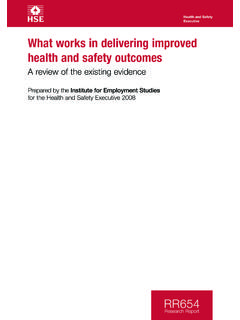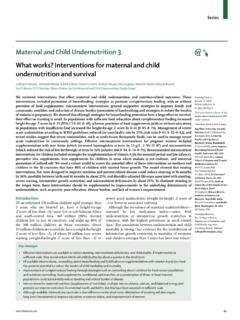Transcription of Regional Committee for Europe Fifty-eighth session
1 WORLD health ORGANIZATION Regional OFFICE FOR Europe Scherfigsvej 8, DK-2100 Copenhagen , Denmark Telephone: +45 39 17 17 17 Fax: +45 39 17 18 18 Electronic mail: World Wide Web address: Regional Committee for Europe Fifty-eighth session Tbilisi, Georgia, 15 18 September 2008 Provisional agenda item 7(c) EUR/RC58/10 +EUR/RC58 28 July 2008 80816 ORIGINAL: ENGLISH Behaviour change strategies and health : the role of health systems Behavioural risk factors are the leading causes of the occurrence of, and morbidity and mortality due to, chronic health conditions and injuries in the world and indeed within the WHO European Region. There is convincing evidence that healthy behaviours including smoking abstinence, weight management, blood pressure control and regular exercise are associated with longer life span and better quality of life.
2 However, health promotion activities and mass public health campaigns in particular have often failed to have the desired effect in terms of reducing disease incidence and burden, simply because compliance with the message, in the form of the intended behaviour change, is harder to achieve than its precursors of raising awareness, providing knowledge and altering attitudes. This paper aims to help Member States and their institutions plan interventions that are feasible, acceptable, equitable and effective in inducing behaviour change leading to healthier lives. Accordingly, the objectives of the paper are: (i) to consolidate the evidence documenting which interventions have been proven to be (cost-) effective under which circumstances in leading to healthy behaviour change; (ii) to outline the critical factors for success and assess their feasibility, robustness and replicability in different settings across the WHO European Region; and (iii) to explore their implications for health systems and the wider government response.
3 The paper argues that for any intervention to be effective, it first needs to have a sound causal and intervention theory backed up with solid evidence. In addition, there has to be a well-documented programme design and implementation strategy, to reach and fully cover the target population and ensure that both programme staff and the population adhere to programme imperatives. Accordingly, proper execution of the main health system functions of stewardship, resource generation, service delivery and financing becomes a determinant of the intermediate objectives of behavioural interventions, namely targeting, full coverage and ensuring user and provider compliance. The Regional Committee discussion on behaviour change strategies is expected to focus on country-based evidence for a selected list of behavioural interventions across the spectrum of personal, population-based, primary and secondary preventive measures, as tracers of specific health system responses along the lines of the conceptual model proposed in the paper, for improved effectiveness, replicability and sustainability under various circumstances.
4 A draft resolution is submitted for the Regional Committee s consideration. Contents Page Why focus on behaviour change? .. 1 What do we know from theory?.. 2 What do we know about what works in practice?.. 2 Theoretical efficacy, or the importance of having sound causal and intervention hypotheses .. 2 Real effectiveness, or the soundness of the implementation hypothesis .. 3 Targeting .. 5 Coverage .. 6 Provider 6 Compliance of the beneficiaries .. 6 Addressing behaviour change through the health system .. 7 Concluding remarks .. 10 Annex 1. A review of behavioural interventions; examples of effective application .. 11 Annex 2. Common factors influencing behaviour change and their implications for intervention design. 18 Annex 3. Components of a comprehensive approach to health behaviour 19 Annex 4. Approaches, tools and likely agents of change.
5 20 21 EUR/RC58/10 page 1 Why focus on behaviour change? 1. Behavioural risk factors are the leading causes of the occurrence of, and morbidity and mortality due to chronic health conditions and injuries in the world. The most prevalent chronic medical conditions in the WHO European Region include cancer, cardiovascular diseases, obstructive lung diseases and diabetes, all of which have in their web of causation at least one predominant risk factor related to unhealthy lifestyles or habits. These include, among others, smoking, lack of physical exercise, high calorie intake and excessive alcohol consumption leading to obesity, high cholesterol levels and high blood pressure as precursors of the occurrence of many noncommunicable diseases. The burden of chronic diseases and injuries, and therefore the relative importance of behavioural factors in health , longevity, health care costs and social welfare, is likely to increase with the ageing of the European population and the improved health care that results in reduced case fatality, and thus higher prevalence over a longer adult life span often spent with co-morbid conditions requiring continuous and more complex medical care.
6 2. There is convincing evidence that healthy behaviours, including smoking abstinence, weight management, blood pressure control and regular exercise, are associated not only with enhanced lifespan but also with good health and function during older age (1). Conversely, estimates of loss of life adjusted for quality attributable to these risk factors vary, but a global assessment of the burden of such risk factors on the quality of life estimated that smoking accounted for of the lost disability-adjusted life years (DALYs) in developed nations (the equivalent figure for alcohol was and for physical inactivity ) (2). 3. Many of these risk factors are modifiable. Increased emphasis on primary prevention obviates the need for more expensive attempts to cure or, as is often the case, for long-term disease management. In the United Kingdom, for example, each quality-adjusted life year (QALY) gained via a brief and targeted smoking cessation intervention costs around 500, while the cost per QALY of treating patients with advanced cancer is estimated at between 40 000 and 50 000.
7 However, what has been proven to work under ideal conditions (such as in efficacy trials) seldom works in real-life conditions (effectiveness). This is because when an experimental project is scaled up to a larger programme, (cost ) effectiveness is determined not by the nature of the intervention but rather by how well the programme targets the population at greatest risk, covers them fully and ensures their compliance with its imperatives. Indeed, health promotion activities and mass public health campaigns in particular have often failed to have the desired effect in terms of reducing disease incidence and burden, simply because compliance with the message, in the form of the intended behaviour change, is harder to achieve than its precursors of raising awareness, providing knowledge and altering attitudes. 4. Indeed, there is more to behaviour change than merely empowering the targeted individuals, communities and populations with the necessary information.
8 By the same token, the argument that individuals should take greater responsibility for their health and health care, and adopt healthier behaviours to avoid ill health in later life, is bound to be simplistic, if not unrealistic or perceptibly accusatory. While increased awareness and knowledge and changed attitudes are necessary to behaviour change, they are seldom sufficient, whence the role of the State and of social institutions in devising and implementing a mix of legislative and regulatory instruments, or using both financial and non-financial incentives to induce change from unhealthy to healthy behaviours for the good of the individual and of society as a whole. 5. This paper aims to help Member States and their institutions plan interventions that are feasible, acceptable, equitable and effective in inducing behaviour change leading to healthier lives.
9 Accordingly, the objectives of the paper are: to consolidate the evidence documenting which interventions have been proven to be (cost-) effective under which circumstances in leading to healthy behaviour change; EUR/RC58/10 page 2 to outline the critical factors for success and assess their feasibility, robustness and replicability in different settings across the WHO European Region; and to explore their implications for health systems and the wider government response. What do we know from theory? 6. Over the past four decades, several models have been developed to explain or predict behaviour change, all of which borrow widely from various disciplines, mainly psychology and medical sociology. Within the field of public health in particular, behaviour change theory is applied to interventions delivered by those working at the levels of the individual ( one-to-one health counselling and advice), the community ( services such as community development and health outreach projects, in settings such as health promoting hospitals or neighbourhood regeneration schemes) and the population ( mass media, targeted campaigns and programmes to increase awareness, regulation of the supply of goods such as tobacco, and legislation governing environmental conditions that promote health such as water supply or spaces for play and exercise).
10 7. There is a need to make a distinction between interventions targeting individuals, settings, communities and populations, and to monitor and document how the determinants of effectiveness rather than efficacy ( accurate targeting of the population at greatest risk, full coverage of those targeted, and ensuring compliance with programme imperatives by both the intended beneficiaries and programme staff) affect the intended outcomes. While targeting, coverage and provider compliance are, in their turn, mainly determined by supply-side factors directly related to programme design and implementation, compliance of programme beneficiaries is more complex, in that it is determined by an individual s behavioural intentions, his/her own abilities to undertake the behaviour change ( values, attitudes and knowledge, habits and behavioural norms, self-perception and capacity for sustaining change of behaviour, and expectations of success or failure before embarking on a change programme) and external environmental factors ( socioeconomic standing, regulatory environment, access to media and advertising campaigns, community and peer expectations).














